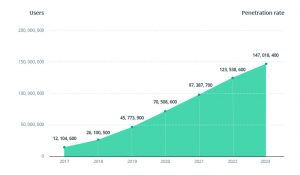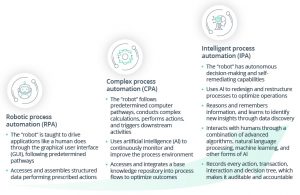How will robotic process automation transform the business landscape for good?
Elon Musk may be raising serious concerns about AI seizing control, but he surely is happy with the way things are going inside SpaceX and Tesla. With hundreds of thousands of documents and digital assets being transferred across departments, offices, and teams every day, neither of his businesses could operate effectively without automation being deeply embedded at every step of the way.
Business process automation has been around for decades — after all, it’s one of the key reasons why IT as we know it once left science labs and landed on billions of office desks around the globe. Getting rid of routine operations and reducing the amount of tedious manual work is what software developers always aspire to achieve.
Today, basic automation is widely used in industries dealing with large volumes of template-based documents, application forms, and other sets of data that require validation, conversion, moving along various workflows or archiving for future use. However, as the complexity of such systems grows, it creates a need for more intelligent, autonomous, and self-sustaining automation solutions. This is why Robotic Process Automation (RPA) came into existence.
What is robotic process automation and why is it a game changer
Metaphorically speaking, RPA is automation on steroids, the next evolutionary step for business process automation technologies and a very important part of the digital transformation process. As the name suggests, it uses robots — or, rather, scripted bots — to imitate the behavior of real users and their interaction with interfaces, data, and other systems. Bots can be very complex and even have decision-making mechanisms, thus enabling fairly sophisticated scenarios within business processes.
RPA fulfills the very important role of relieving users of the burden of dealing with repetitive, monotonous, dreary tasks that wear them out and take them away from higher-value work that requires human reasoning, creativity, critical thinking and, importantly, face-to-face human interactions. Bots never get tired or demotivated, can work 24/7, and never procrastinate before jumping onto a new task.
In addition, robotic process automation typically does not require software development in the conventional sense, thus saving time and money for companies undertaking RPA initiatives. However, it doesn’t mean that RPA is a point-and-click technology that can be arbitrarily deployed by any employee. Successful cases of robotic process automation implementation are based on professional business analysis, deployment and configuration of an RPA framework, and its continuous improvement.
The enterprise RPA trend is strong and expected to hit the 3 billion–dollar mark by 2021. According to a global Deloitte survey, over half of large enterprises are already embedding RPA in their business processes and enjoying the immediate positive effects. These investments have a surprisingly short payback period of less than 12 months and come with a number of complimentary bonuses on the side: from improved compliance and higher quality to soaring productivity and overall cost reduction.
The benefits of robotic process automation can be narrowed down to several areas:
- Compliance
Industries having to deal with strict compliance requirements are among the first beneficiaries of RPA implementation. With higher accuracy and fewer errors, companies will be spending less time and effort dealing with the ramifications of compliance issues.
- Business optimization
RPA tools channel employees’ focus and efforts toward higher-value tasks and boost the effectiveness of business operations in general. In addition, RPA products may result in eliminating redundant, automatable positions, thus optimizing the payroll.
- Risk reduction
On top of reducing general risks that are typically associated with human error and oversight, the wide adoption of robotic process automation helps mitigate scalability risks, since bots and automation scenarios can be easily and quickly adapted to new business processes and even legacy systems.
- Customer satisfaction
With a shorter turnover time and a higher quality of service, RPA adopters are very likely to see growing customer loyalty, fewer support requests, and more business coming their way. With RPA, customers will be making fewer data entry mistakes and may not need to contact the support service to correct their information.
- Employee satisfaction
As mentioned before, RPA takes away the need to spend time on monotonous manual operations that bots deal with much more effectively. Employees can now automate parts or even all of the business processes that they used to be involved in, which translates into higher job satisfaction and lower attrition.
At the same time, it’s important to distinguish between RPA and the yet nascent cognitive or intelligent automation, a much more advanced and technically complex discipline based on natural language processing, speech synthesis, advanced computer vision, machine learning, and many other technologies that are still evolving.
Intelligent automation continuum
Source: IBM
Key RPA takeaways for different industries
In order to better understand the impact of this technology on different industries, let’s take a look at some robotic process automation examples representing several industries.
Insurance
Anyone who has ever purchased an insurance policy knows how long and tiresome this process can be. People on the inside know it far better. The industry is notorious for being overburdened with repetitive manual tasks, scoring algorithms, countless forms and documents that need to be filled out, and other actions that are repeated for every new policy or every case review.
RPA solutions have tremendous potential of “taking the robot out of the human”, as Leslie Wilcocks, professor of technology, work, and globalization at the London School of Economics, put it in his interview to McKinsey. In insurance, typical activities like underwriting and claims registration require a tremendous amount of data collection/scraping, checking and validation involving external sources. The processes are largely uniform across the board, which makes them perfect candidates for deep automation using bots.
In addition, the insurance industry has very strict compliance requirements and follows detailed guidelines to ensure the clarity of audit trails. Manual processing by error-prone humans has every chance of creating serious regulatory breaches.
All of the above makes for a perfect robotic process automation use case. Properly implemented RPA mechanisms reliably protect insurers and the insured from critical errors in documentation, help maintain regulatory compliance, and keep employee motivation high while offering top-notch customer experience.
Transportation and logistics
Transportation is all about getting people or cargo from A to B within the shortest time possible in a safe and comfortable way. These services are based on a number of important subprocesses, each being a potentially good example of robotic process automation:
- Scheduling
- Managing loads
- Fleet management
- Order processing
- Order tracking
- Invoice processing
- Reporting
- Communications and customer support
These and many other activities have a lot to do with scraping data from physical and electronic documents, external sources, and interfacing with various systems. RPA is perfectly suited for transportation needs and can help optimize route planning, minimize LTL (less-than-load) shipments, curtail payment periods, minimize shipment delays and create a reliable system of service-to-customer communications.
Government
Governments are traditionally considered to be extremely inefficient (but it’s changing!) in rendering their services. Public agencies are arguably the largest receivers and processors of countless forms, applications, claims, and other documents requiring quick turnover. With their well-defined processes, government institutions are a perfect fit for RPA implementation, which would result in the provision of faster and higher-quality services to the citizens.
Although RPA in its present state cannot solve all the issues governments traditionally face, it can free up resources stuck in manual tasks and enable them to attend to higher-importance assignments within respective organizations. At the same time, RPA should not be made the ultimate goal in and of itself. Rather, it should be an element of a larger transformative agenda aiming to boost the effectiveness of government services.
Procurement
In any organization, procurement is one of the more cumbersome services and a drag on the work of pretty much every other unit or department. Contract management, risk management, purchase order management, category management, supplier relations — this is just a short list of tasks that procurement departments handle in most companies. Their processes are rigid and inflexible, their workflows are sluggish and even the slightest delay can trigger a butterfly effect resulting in important decisions getting stuck in the pipeline.
Fortunately, such activities have every characteristic of good robotic process automation use cases. Bots can automatically collect information from corresponding systems or designated users, push documents down the line and minimize processing delays to everyone’s benefit. Moreover, RPA tools can perform some elements of risk analysis by scanning documents, going through contracts, scoring the effects of particular actions or even making simple decisions based on a set of predefined criteria.
Drawing the line
RPA is steadily winning the hearts and minds of CEOs, CTOs, and other technology leaders around the world. With just a few reservations that adopters should be mindful about, robotic process automation benefits are fairly self-evident. RPA is a stepping stone for a much larger initiative to automate routine tasks with the help of artificial intelligence, machine learning, and complex cognitive mechanisms that are expected to completely replace humans in non-critical tasks.
As we have seen in the robotic process automation examples above, the scope of automatable activities is nearly infinite. However, RPA implementation isn’t just a matter of purchasing the right tools and hiring a robotic process automation developer. It requires a comprehensive approach to systems and business analysis followed by business process adjustments and low-level adaptation of RPA products to your business reality.
Read the original article here. Find out more about Intellias here.




